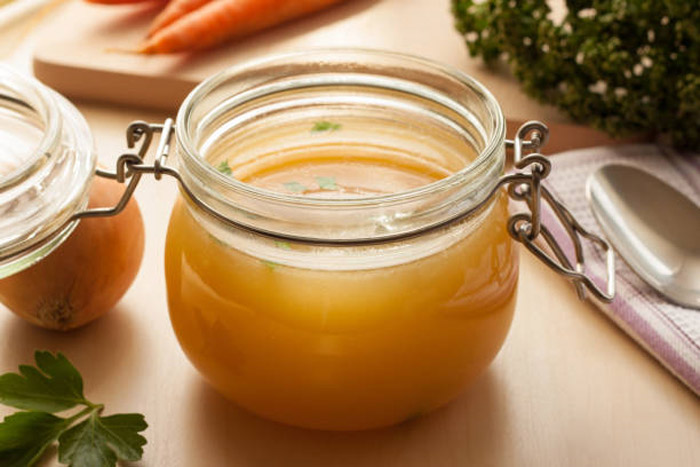Is making broth part of your cooking routine? It has been part of mine for many years. Slow simmered roasted bones with my favourite assortment of veggies and herbs provides me with tasty and healthy broth I can use as a base for many comforting meals, especially valuable now as we head into the cold months of the year.
In days gone by, when the butcher sold meat on the bone rather than individual fillets or whole chickens rather than boneless breasts, our thrifty ancestors made use of every part of the animal by preparing stock, broth or bouillon from the extra bony portions.
This month we continue our series Eating Local on a Budget. Last month when Leah Bouchard encouraged readers to buy meat direct from the farm, she suggested saving the bones and asking for the extras that often get thrown out such as chicken feet. Another thrifty option is to get in the habit of using the leftover bones after you cook a roast.
Not only is bone broth tasty, but bone broth – real bone broth, made from whole roasted bones – is touted for its health effects. Animal bones are packed with vitamins, minerals and collagen, all of which seep into the broth when slow simmered in water. The end result: a healthy liquid that can help ease digestion, fight inflammation, and even improve sleep.
Here is one way to do it: When starting with raw bones, roast them in a hot oven. This intensifies the flavour of the broth and adds richness you can’t otherwise achieve, so don’t skip this step.
Next, cover the bones in water and set over the stove-top. (You may also use a crock pot or slow cooker.) Add a bit of apple cider vinegar to help break down the collagen while infusing the broth with a nice tangy zip. Let the bone broth simmer for 10-12 hours, occasionally skimming off the excess fat and sediment at the top with a fine mesh strainer.
When there’s about four hours of cook time left, add your favourite veggies and herbs. Some suggested add-ins are: onion, garlic cloves, celery, carrots, fennel bulb and fronds, rosemary, thyme, bay leaves and peppercorns. Keep in mind that you don’t need to add any veggies to the bone broth, but it helps to balance the flavour and adds even more antioxidants to the broth.
When the broth is complete, let it cool down to room temperature. As it cools, there will be some gelling and a thin layer of fat at the top. Do not discard this! These contain the vital nutrients that bone broth is known for and is a sign you made your bone broth correctly.
Store your cooled bone broth in sterilized glass jars. It will keep for five days in the fridge, or up to a year in the freezer.
Use your homemade bone broth in soups, stews, gravy, and any recipe that calls for stock. You can even try it as a recovery drink after a tough workout.
Brought to you by the Stuartburn Emerson-Franklin Local Food Initiative.




